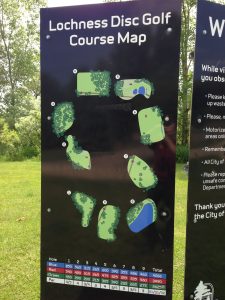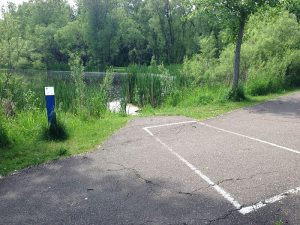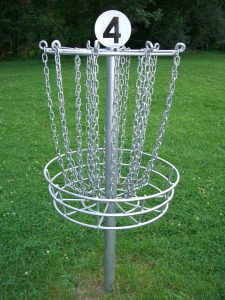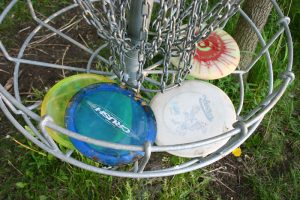
Fore!
What did you think of when you read that? Your mind most likely jumped to golf. Maybe disc golf popped into your head, but it’s not far-fetched to assume that, no, it didn’t.
Surprisingly, disc golf has been around since the 1970s, yet not too many people know about it. Some are quick to lump it in with ultimate Frisbee. In actuality, though, the only similarity these two sports have in common is that they both use a disc.
If you’re wondering how to play disc golf, this is the article for you! After reading it, you’ll know the rules, the kinds of discs you need, and a couple of basic throwing techniques.
What you need to know about disc golf:

Photo courtesy of Runner1928, from Wikimedia Commons.
The rules for disc golf aren’t too different from regular golf. Let’s get right into them.
The first thing you should do is look for a course map. The course map will have information on the holes: yardage, par, difficulty, etc. It’ll also have rules listed. Rules vary from course to course, but there are usually some constants:
- Out-of-bounds throws are typically accompanied by a one-stroke penalty. The player who throws a disc out of bounds will then play it from the spot it went out.
- Breaking branches off trees may result in a two-stroke penalty on some courses.
- Players must use marker discs to keep track of where their discs land. This is similar to golf, when players use a coin to mark the spot where their ball landed. Marker discs are small discs that only serve the purpose of marking the spot where the actual disc landed.
- When throwing, the foot you put your weight on, a.k.a. the plant foot, cannot pass the marker disc. Place it as close as possible to the front of the lip of the marker disc. Every inch matters in disc golf.

Photo courtesy of Runner1928, from Wikimedia Commons.
At the start of each hole, you will throw your disc from the tee area. On the first hole, you need to figure out which player will be teeing off first.
How do you decide? Flip a disc. The side with the logo can act as heads and the back side, tails.
Subsequent holes are decided by who did better on the previous hole. Whoever had the lower score tees off first.
When teeing off, your plant foot must be in the tee area. Once you’re in position, let the disc fly.
Remember to keep track of how many strokes each hole takes. When you finish a hole, mark it down on either your phone or a scorecard. The player with the lowest amount of strokes at the end of the course wins.
Stepping past the marker disc after your throw is allowed at all points of the game, except when you are putting. You cannot follow through with your leg in any putting situation.

Photo courtesy of Christian Gidlöf, from Wikimedia Commons.
In case you’ve never seen a disc golf hole, also known as a cage, before, we’ve put one here.
To score, land your disc in the basket or chains. Then tally up how many throws it took to reach the cage, and mark it down.
If there happens to be another group who is playing through the course faster than you and they catch up, it is proper sportsmanship to let them play through. This way, they don’t have to keep waiting for you to finish each hole.
You may have to wait a short while for them to complete the hole, but because you’re playing at a slower pace, you won’t have to worry about running into them again.
Can’t have disc golf without the disc!
It’s right there in the name: disc golf. You don’t need a caddie to drag around a bag full of clubs and balls because you don’t need any of that gear. All you need are a few special discs. You can purchase a starter set here.
Disc golf discs normally have their weights listed on the back. When you get your discs, write your name and phone number on the back of them in permanent marker. This is in case one of your discs gets lost while you’re playing. That way, if someone finds your disc, they can contact you to return it.

Photo courtesy of Daveswagon, from Wikimedia Commons.
There are three types of discs in disc golf. Driver discs are used to tee off on holes.
Drivers have pointier edges, which cut through the air more effectively. Much like a driver in golf is built to propel the ball as far as possible, a driver disc functions the same way.
Mid-range discs act like middle irons. As you get closer to the hole, you don’t want to be throwing a driver disc. You need something that won’t carry as far.
Mid-range discs have thicker, more rounded edges. The reasoning behind this is that, while they won’t sail through the air like drivers, they can be thrown more accurately. Proper aim becomes more important the closer you get to the cage.
The final disc type is the putter. It’s the disc equivalent to a putter in golf.
Like mid-range discs, putters have thick, rounded edges. Out of all three disc types, putters allow you to have the most control over your throws. Putters do not fly very far, but you can count on them going exactly where you aim them. This is the disc that you’ll be throwing into the hole.
Types of throws:
There are two main throws you’ll want to know when playing disc golf. Being able to do these two types of throws will be enough to get you through 99% of the situations you’ll encounter.
Backhand
This first throw is the one that everyone knows: the backhand. Check out this video to see how to correctly grip and throw a disc backhanded.
Forearm or Flick
The other main throw is referred to as either a forearm throw or flick. The flick is a little tougher to figure out initially. However, it is just as vital of a throw as the backhand. This video teaches the proper form for a flick.
You’re going to want to be well-versed in both of these throws before stepping foot on a disc golf course.
Now you’re ready!
With a bit of practice, you should soon be ready to hit the course. And if you aren’t sure where to find a disc golf course near you, use this nifty site.
All you have to do is enter your zip code and set the mile radius to your desired distance; Disc Golf United’s database will handle the rest. You might be surprised to find that there are plenty of disc golf courses nearby that you never knew about!
